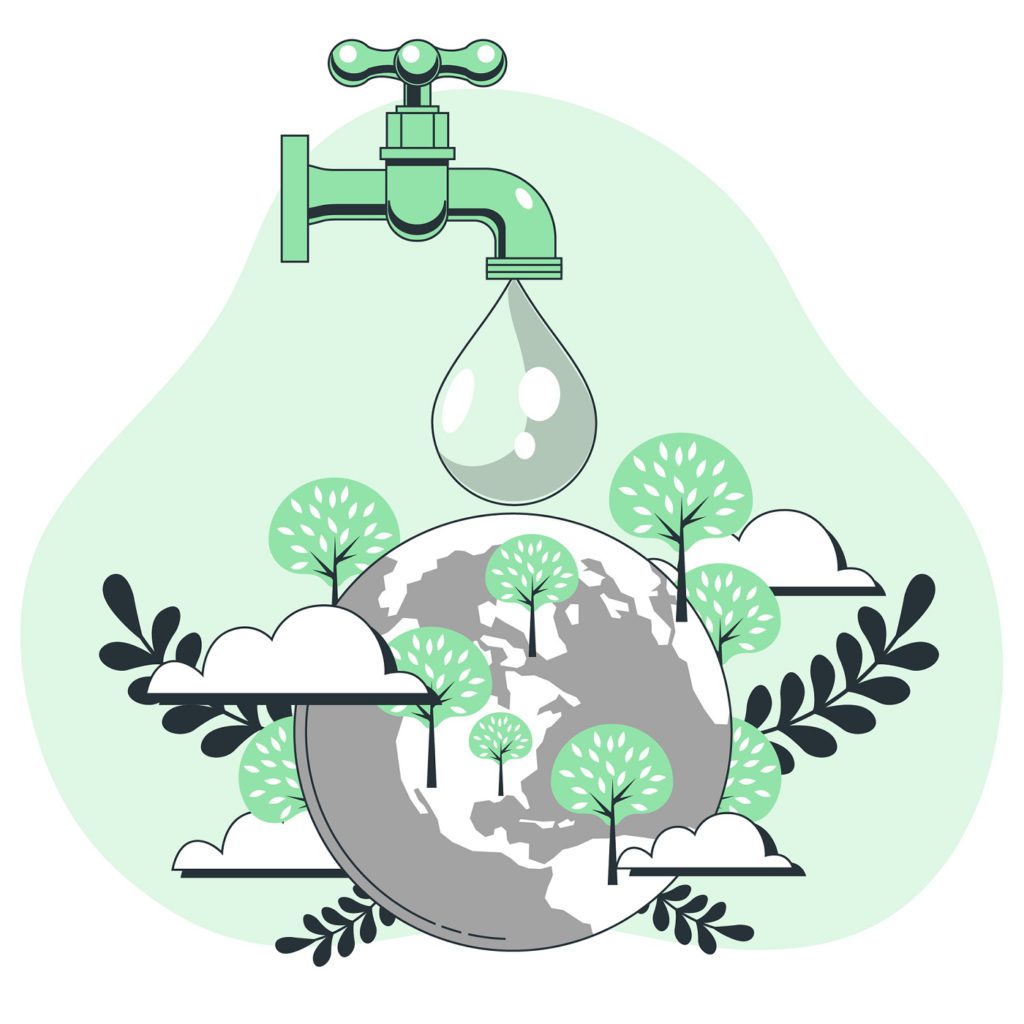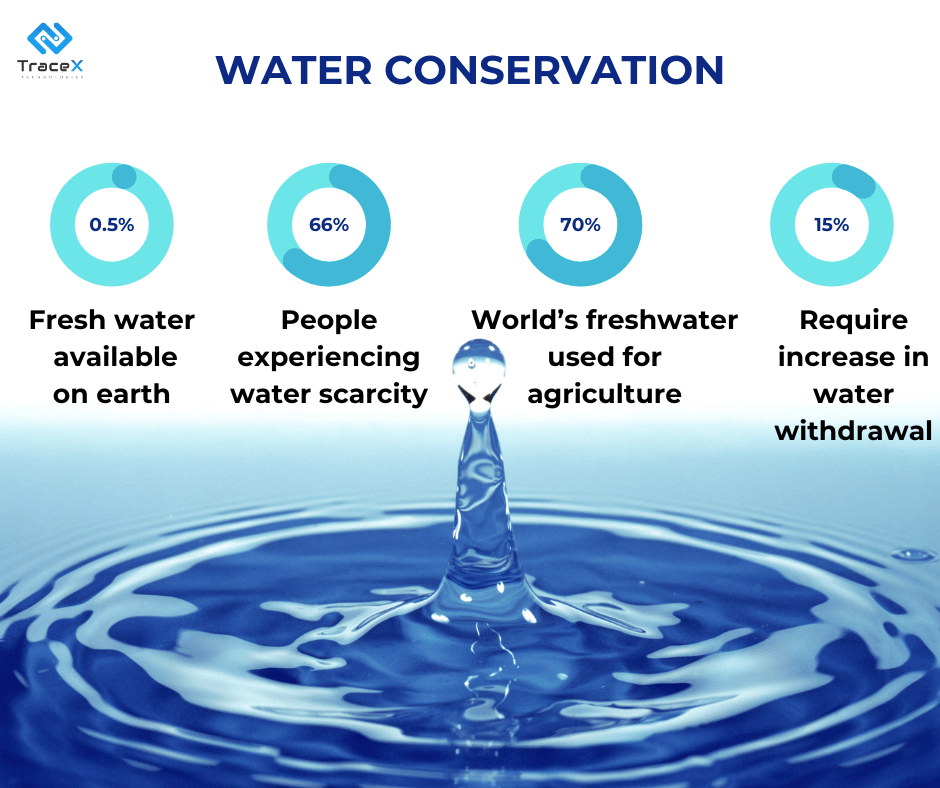
Aftermath Of COVID-19 in Seafood Traceability
Disruption in fish production, new regulations, and increasing consumer demand for safe products has made the seafood supply chain traceability the new norm with blockchain solutions.

Water is one of the most precious resources on our planet, essential for sustaining life and supporting ecosystems. However, with growing populations, industrialization, and climate change, the availability of clean and fresh water is becoming increasingly scarce. In light of these challenges, water conservation and stewardship have emerged as critical practices to ensure the sustainable management of our water resources.
Water conservation refers to the careful and responsible management of water resources to reduce waste, optimize efficiency, and preserve water quality. It plays a pivotal role in safeguarding the environment, protecting ecosystems, and meeting the needs of present and future generations.
Environmental Sustainability:
Economic Viability:
Social Equity:
Water stewardship goes beyond conservation and encompasses a holistic approach to managing water resources sustainably. It involves stakeholders from diverse sectors working together to balance competing water demands, mitigate risks, and address water-related challenges collaboratively.
Water stewardship considers the entire water cycle, from source to consumption to return, and emphasizes integrated approaches to water management. It involves assessing the social, environmental, and economic impacts of water use and implementing strategies to minimize negative outcomes and maximize benefits.
Effective water stewardship requires collaboration among governments, businesses, communities, and civil society organizations. Stakeholder engagement and participatory decision-making processes are essential for building consensus, fostering cooperation, and achieving shared water management goals.
Water conservation is essential across diverse sectors, including agriculture, industry, and urban areas, to address water scarcity, promote sustainability, and mitigate the impacts of climate change.

Water is a finite resource essential for sustaining life, ecosystems, and human activities. While approximately 71% of the Earth’s surface is covered in water, only a small percentage is freshwater available for human consumption. The distribution of freshwater resources is uneven across the globe, with some regions experiencing abundance while others face scarcity. The availability of freshwater depends on factors such as precipitation patterns, topography, and human activities.
Water scarcity refers to the imbalance between water availability and demand, where the demand for water exceeds the available supply. Water scarcity can be influenced by various factors, including population growth, urbanization, climate change, and inefficient water management practices. The implications of water scarcity are profound and can have far-reaching consequences for both human populations and the environment.
Population growth and climate change are two key drivers exacerbating pressures on water resources and water scarcity worldwide.
Water conservation involves the responsible and efficient use of water resources to minimize waste and ensure the sustainable management of freshwater supplies. The principles of water conservation encompass a range of practices aimed at reducing water consumption, promoting water efficiency, and protecting water quality. Key principles include:
Reduce Water Waste:
Improve Water Efficiency:
Preserve Natural Water Sources:
Promote Sustainable Water Management:
Strategies for Reducing Water Consumption in Different Sectors:
Water conservation strategies vary across different sectors, including agriculture, industry, and households, tailored to the specific water use requirements and challenges of each sector:
Agriculture:
Industry:
Households:
India’s extensive rice cultivation is exacerbating the water crisis, with irrigated rice production being a significant contributor to the greenhouse gas methane (CH4).
Implementing TraceX solutions, VNV improved tracking of irrigation practices in Rice cultivation.
Technology plays a crucial role in addressing water conservation challenges by providing innovative solutions to monitor, manage, and optimize water use efficiently. From smart sensors to advanced data analytics, technological advancements offer new opportunities to enhance water conservation efforts across various sectors.
Water stewardship in agricultural practices is paramount for ensuring the sustainable utilization of water resources. Firstly, it plays a vital role in maintaining the delicate balance of water availability for agricultural activities, particularly in regions prone to water scarcity or drought. Efficient water stewardship practices help to conserve water and ensure its availability for future generations.
Water is indispensable for crop production, as it directly influences plant growth, development, and yield. Adequate water supply is crucial for sustaining agricultural productivity and food security. Moreover, water is essential for maintaining soil health and fertility, as it facilitates nutrient uptake by plants and supports microbial activity in the soil. By practicing water stewardship, farmers can optimize soil moisture levels, prevent soil erosion, and preserve soil structure, thereby enhancing overall soil health and productivity.
Furthermore, water stewardship contributes to ecosystem preservation by conserving natural water bodies, wetlands, and riparian habitats. Sustainable water management practices safeguard aquatic ecosystems, biodiversity, and wildlife habitats, thereby promoting ecological resilience and environmental sustainability.
In addition to environmental benefits, water stewardship practices yield social and economic advantages for farmers and communities. By conserving water and improving water-use efficiency, farmers can reduce production costs, enhance crop yields, and increase farm profitability. Moreover, sustainable water management practices contribute to community resilience by ensuring access to clean water for drinking, sanitation, and household needs.
Overall, implementing water stewardship practices in agriculture is essential for ensuring the sustainable use of water resources, enhancing agricultural productivity, preserving ecosystems, and promoting socio-economic well-being in farming communities.
Techniques for sustainable irrigation and water management on farms are crucial for maximizing water use efficiency and minimizing wastage.
Drip irrigation, sprinkler irrigation, and micro-irrigation systems are among the most efficient irrigation methods available. These systems deliver water directly to the root zone of plants, minimizing evaporation and runoff. Precision irrigation techniques, such as drip irrigation, allow for precise control over water application, ensuring that plants receive the optimal amount of water they need for growth.
Soil health practices, including mulching, cover cropping, and contour farming, play a vital role in soil moisture management. Mulching involves covering the soil surface with organic materials, such as straw or compost, to retain moisture, suppress weed growth, and reduce soil erosion. Cover cropping involves planting cover crops, such as legumes or grasses, to protect the soil from erosion, improve soil structure, and enhance moisture retention. Contour farming involves cultivating crops along the contour lines of the land to reduce water runoff and soil erosion.
Adoption of soil moisture sensors and moisture retention techniques allows farmers to monitor and manage soil water content effectively. Soil moisture sensors provide real-time data on soil moisture levels, enabling farmers to adjust irrigation schedules and water application rates accordingly. Moisture retention techniques, such as conservation tillage and organic matter addition, help improve soil water holding capacity, reducing the need for frequent irrigation and conserving water resources.
TraceX has been at the forefront of supporting enterprises in tracking and monitoring water conservation practices in sustainable agriculture. Through our innovative solutions, we have collaborated with numerous organizations to implement robust systems for monitoring water usage, identifying areas of inefficiency, and optimizing irrigation practices. By leveraging advanced technologies such as remote sensing, data analytics, and blockchain, TraceX empowers enterprises to gain real-time insights into their water management processes. This enables them to make informed decisions, implement targeted interventions, and drive continuous improvement in water conservation efforts. With TraceX, enterprises can effectively track their progress towards sustainability goals, mitigate water-related risks, and contribute to the long-term resilience of agricultural ecosystems.
In conclusion, addressing the challenges and seizing the opportunities in water conservation and stewardship requires a multi-faceted approach involving policy interventions, technological innovations, capacity building, and stakeholder collaboration to achieve long-term sustainability in water management.
In conclusion, water conservation and stewardship are paramount for ensuring the sustainable management of water resources and safeguarding ecosystems, livelihoods, and food security. By addressing the challenges, embracing emerging opportunities, and implementing innovative strategies, we can collectively advance towards a future where water is managed wisely, equitably, and sustainably. Through collaborative efforts, policy support, technological innovation, and community engagement, we can achieve lasting solutions that not only mitigate water scarcity but also promote resilience, prosperity, and well-being for present and future generations. Together, let us commit to preserving our most precious resource and building a more water-secure and resilient world for all.

Disruption in fish production, new regulations, and increasing consumer demand for safe products has made the seafood supply chain traceability the new norm with blockchain solutions.
The problems faced by Seafood industry, one of the world’s first and largest commercial enterprises in the food industry are overfishing, illegal, unreported, unregulated (IUU) fishing, and bycatch. Emerging solutions in blockchain-based food traceability address these practices.

Learn about the critical role of traceability in ensuring food safety. Explore the significance of traceability systems like TraceX in tracking food products from farm to table, identifying hazards, and mitigating risks.
Leverage Blockchain enabled traceability platform for enhanced supply chain visibility
WhatsApp us